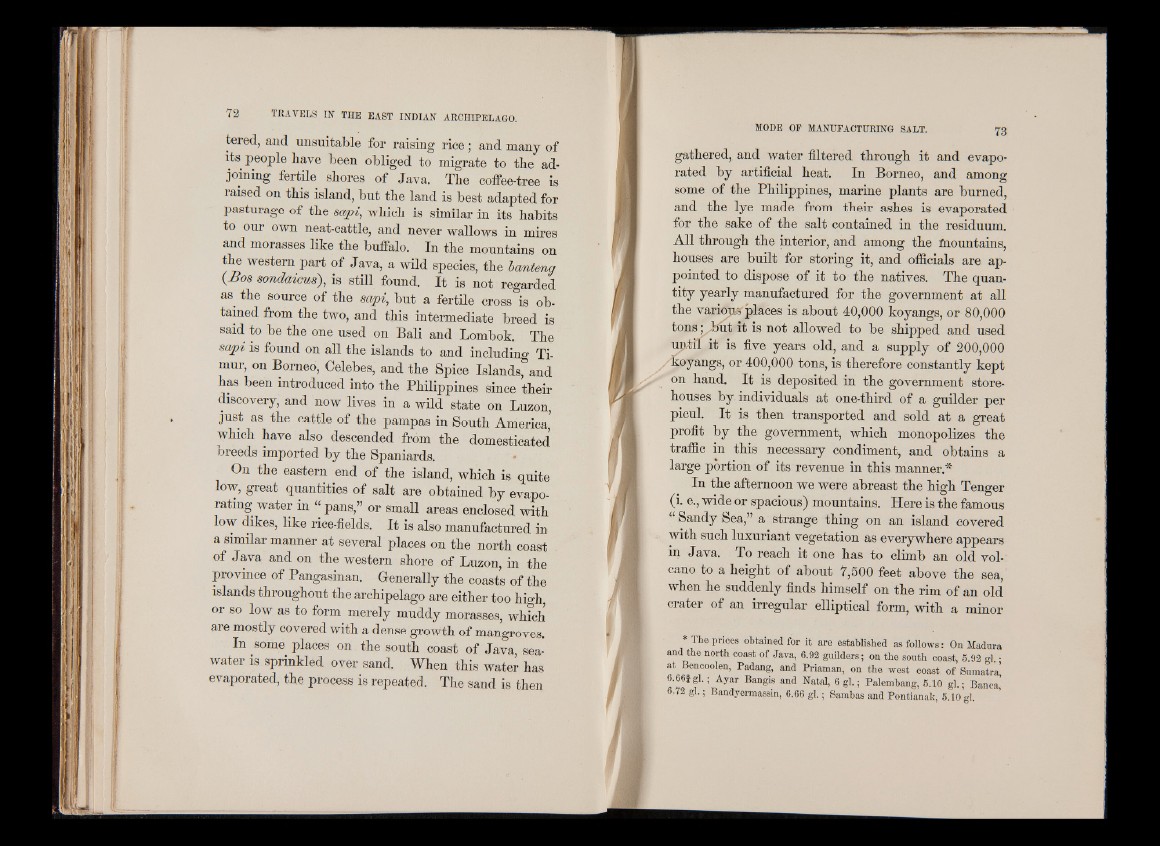
tered, and unsuitable for raising rice; and many of
ifr people have been obliged to migrate to the adjoining
fertile shores of Java. The coffee-tree is
raised on this island, but the land is best adapted for
pasturage of the sapi, which is similar in its habits
to our own neat-cattle, and never wallows in mires
and morasses like the buffalo. In the mountains on
the western part of Java, a wild species, the bcmteng
{Bos sondaicus), is still found. It is not regarded
as_ tiie source of the sapi, but a fertile cross is obtained
from the two, and this intermediate breed is
said to be the one used on Bali and Lombok. The
sapi is found on all the islands to and including Timur,
on Borneo, Celebes, and the Spice Islands, and
has been introduced into the Philippines since their
discovery, and now lives in a wild state on Luzon,
just as the cattle of the pampas in South America,
which have also descended from the domesticated
breeds imported by the Spaniards.
On the eastern end of the island, which is quite
low, great quantities of salt are obtained by evaporating
water in “ pans,” or small areas enclosed with
low dikes, like rice-fields. It is also manufactured in
a similar manner at several places on the north coast
of Java and on the western shore of Luzon, in the
province of Pangasinan. Generally the coasts of the
islands throughout the archipelago are either too high,
or so low as to form merely muddy morasses, which
are mostly covered with a dense growth of mangroves.
In some places on the south coast of Java, seawater
is sprinkled over sand. When this water has
evaporated, the process is repeated. The sand is then
MODE OF MANUFACTURING SALT. 73
gathered,, and water filtered through it and evaporated
by artificial heat. In Borneo, and among
some of the Philippines, marine plants are burned,
and the lye made from their ashes is evaporated
for the sake of the salt contained in the residuum.
All through the interior, and among the mountains,
houses are built for storing it, and officials are appointed
to dispose of it to the natives. The quantify
yearly manufactured for the government at all
the variops places is about 40,000 koyangs, or 80,000
tons r jiu t it is not allowed to be shipped and used
upM it is five years old, and a supply of 200,000
koyangs, or 400,000 tons, is therefore constantly kept
on hand. It is deposited in the government storehouses
by individuals at one-third of a guilder per
picul. It is then transported and sold at a great
profit by the government, which monopolizes the
traffic in this necessary condiment, and obtains a
large portion of its revenue in this maim p i t *
In the afternoon we were abreast the high Tenger
(i. e., wide or spacious) mountains. Here is the famous
“ Sandy Sea,” a strange thing on an island covered
with such luxuriant vegetation as everywhere appears
in Java. To reach it one has to climb an old volcano
to a height of about 7,500 feet above the sea,
when he suddenly finds himself on the rim of an old
crater of an irregular elliptical form, with a minor
* The prices obtained for it are established as follows: On Madura
and the north coast of Java, 6.92 guilders; on the south coast, 5.92 gl. •
at Bencoolen, Padang, and Priaman, on the west coast of Sumatra!
6-66J g l.; Ayar Bangis and Natal, 6 g l.; Palembang, 5.10 gl.; Banca
6-72 gl.; Bandyermassin, 6.66 gl.; Sambas and Pontianak, 5.10 gl.